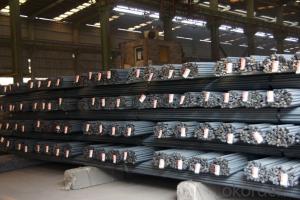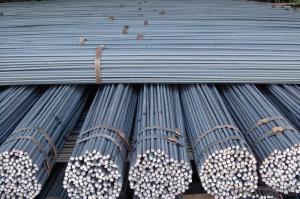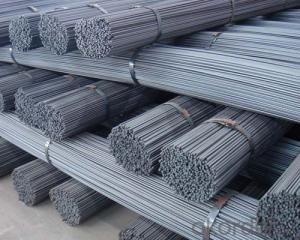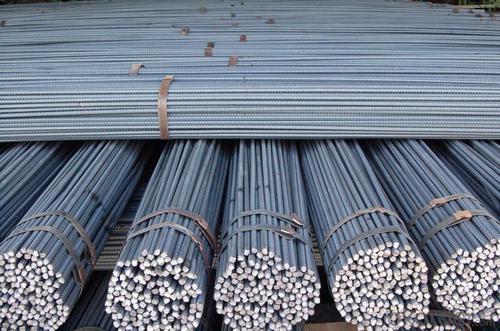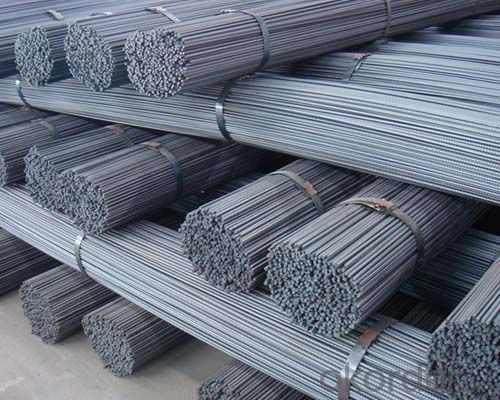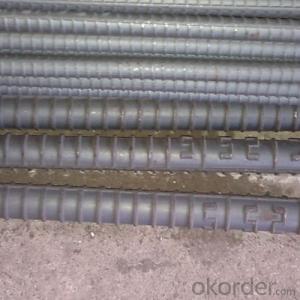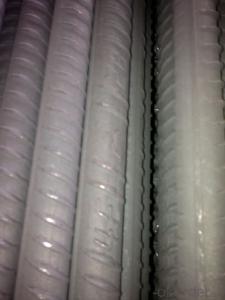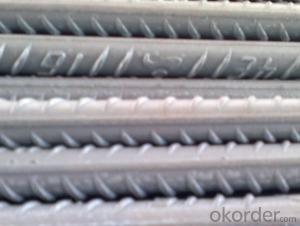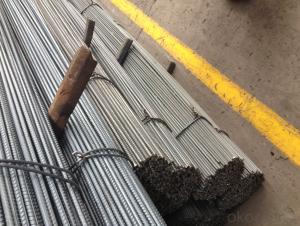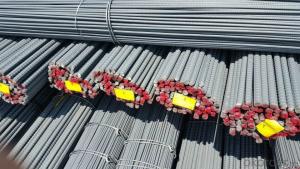HRB400 deformed bars with competitive price
- Loading Port:
- Tianjin
- Payment Terms:
- TT OR LC
- Min Order Qty:
- 25 m.t.
- Supply Capability:
- 100000 m.t./month
OKorder Service Pledge
OKorder Financial Service
You Might Also Like
Product Description:
Specifications of HRB400 Deformed Steel Bar:
Standard | GB | HRB400 | |
Diameter | 10mm-32mm | ||
Length | 6M, 12M | ||
Place of origin | Hebei, China mainland | ||
Advantages | exact size, regular package, chemical and mechanical properties are stable. | ||
Type | Hot rolled deformed steel bar | ||
Chemical Composition: (Please kindly find our chemistry of our material based on HRB400 as below for your information)
Grade | Technical data of the original chemical composition (%) | ||||||
C | Mn | Si | S | P | V | ||
HRB400 | ≤0.25 | ≤1.60 | ≤0.80 | ≤0.045 | ≤0.045 | 0.04-0.12 | |
Physical capability | |||||||
Yield Strength (N/cm²) | Tensile Strength (N/cm²) | Elongation (%) | |||||
≥400 | ≥570 | ≥14 | |||||
Theoretical weight and section area of each diameter as below for your information:
Diameter(mm) | Section area (mm²) | Mass(kg/m) | Weight of 12m bar(kg) |
18 | 254.5 | 2.00 | 24 |
20 | 314.2 | 2.47 | 29.64 |
22 | 380.1 | 2.98 | 35.76 |
Usage and Applications of HRB400 Deformed Steel Bar:
Deformed bar is widely used in buildings, bridges, roads and other engineering construction. Big to highways, railways, bridges, culverts, tunnels, public facilities such as flood control, dam, small to housing construction, beam, column, wall and the foundation of the plate, deformed bar is an integral structure material. With the development of world economy and the vigorous development of infrastructure construction, real estate, the demand for deformed bar will be larger and larger..
Packaging & Delivery of HRB400 Deformed Steel Bar:
Packaging Detail: products are packed in bundle and then shipped by container or bulk vessel, deformed bar is usually naked strapping delivery, when storing, please pay attention to moisture proof. The performance of rust will produce adverse effect.
Each bundle weight: 2-3MT, or as required
Payment term: TT or L/C
Delivery Detail: within 45 days after received advanced payment or LC.
Label: to be specified by customer, generally, each bundle has 1-2 labels
Trade terms: FOB, CFR, CIF

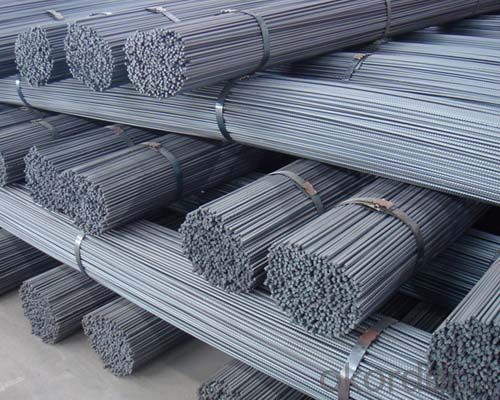
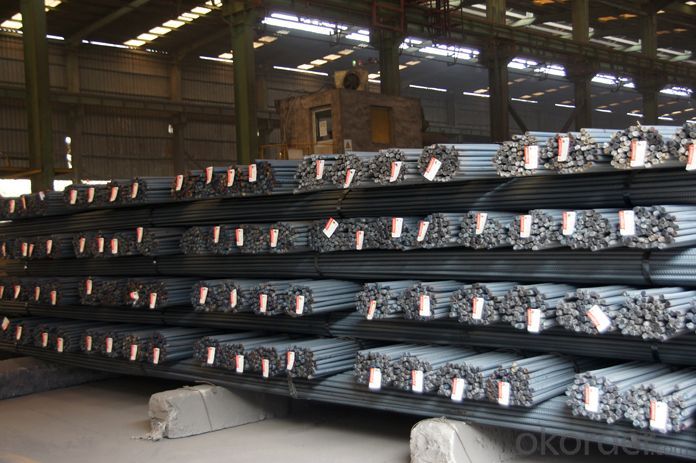
*If you would like to get our price, please inform us the size, standard/material and quantity. Thank you very much for your attention.
- Q: Are steel rebars suitable for earthquake-resistant structures?
- Yes, steel rebars are suitable for earthquake-resistant structures. Steel rebars provide excellent tensile strength and reinforcement to concrete structures, making them more resistant to the lateral forces and vibrations caused by earthquakes. They help to distribute and absorb the energy generated during seismic events, enhancing the overall structural integrity and reducing the risk of collapse. Steel rebars have been widely used in earthquake-prone areas and are considered a reliable choice for ensuring the safety and stability of buildings and infrastructure during earthquakes.
- Q: How do steel rebars contribute to the fire resistance of a structure?
- Steel rebars contribute to the fire resistance of a structure by providing reinforcement and stability to the concrete. In the event of a fire, steel rebars help to maintain the structural integrity of the building by preventing the concrete from cracking or collapsing. The high melting point of steel also allows it to retain its strength and structural integrity even at high temperatures, which helps to slow down the spread of fire and allow occupants to safely evacuate the building.
- Q: Can steel rebars be used in structures exposed to extreme weather conditions?
- Yes, steel rebars can be used in structures exposed to extreme weather conditions. Steel rebars are known for their durability, strength, and resistance to corrosion, making them suitable for withstanding harsh weather elements such as high winds, heavy rain, and extreme temperatures. Additionally, when properly coated with protective materials, steel rebars can provide enhanced resistance against weathering effects, ensuring the longevity and structural integrity of the building.
- Q: What are the fire resistance properties of steel rebars?
- Steel rebars have excellent fire resistance properties due to their high melting point and low thermal conductivity. They do not burn or contribute to the spread of fire. In case of a fire, steel rebars maintain their structural integrity and can help in preventing the collapse of a building or structure.
- Q: Are steel rebars suitable for use in structures with high resistance to impact?
- Steel rebars are generally suitable for use in structures with high resistance to impact. Rebars, also known as reinforcement bars, are made from steel and are commonly used in concrete structures to enhance their strength and durability. Steel is known for its high tensile strength and ability to absorb and distribute impact forces, making it an ideal material for reinforcement. In structures that are prone to impact, such as bridges, highways, or buildings located in earthquake-prone areas, steel rebars play a critical role in providing additional strength and resistance. The use of rebars ensures that the structure can withstand sudden impact loads and prevent catastrophic failures. Moreover, steel rebars are available in various grades and sizes, allowing engineers to select the appropriate type of rebar based on the specific requirements of the structure. Higher grade rebars, such as Grade 60 or Grade 75, offer increased strength and ductility, making them even more suitable for structures with high resistance to impact. It is important to note that while steel rebars enhance the overall strength and impact resistance of a structure, other factors such as design, construction techniques, and maintenance also play vital roles in ensuring the structure's ability to withstand impact forces. Therefore, a comprehensive approach that considers all these factors is essential in designing and constructing structures with high resistance to impact.
- Q: How do steel rebars enhance the bond between concrete and reinforcement?
- The bond between concrete and reinforcement is improved by steel rebars through various mechanisms. Firstly, the inclusion of rebars in concrete enhances the mechanical interlock between the two materials. As concrete surrounds the rebars, it fills the spaces between the steel bars, resulting in a strong bond once it solidifies. This mechanical interlock effectively prevents the separation of concrete and reinforcement, particularly when subjected to tensile loads. Secondly, steel rebars augment the bond by offering additional surface area for adhesion. The rough texture of the rebars allows the concrete to firmly grip the steel surface, leading to a stronger bond. This adhesion is further enhanced by the formation of corrosion products on the rebars over time, creating an even rougher surface and increasing the bond strength between the concrete and reinforcement. Thirdly, rebars serve as load transfer devices in concrete structures. When external forces act on the structure, the rebars distribute and transfer these forces to the surrounding concrete. This load transfer mechanism significantly improves the overall structural integrity and performance of the concrete element. Furthermore, steel rebars also reinforce the bond between concrete and reinforcement by their ability to resist deformation. Under tensile loads, the rebars elongate and absorb the stress, preventing the concrete from developing cracks. This prevents the formation of cracks that could compromise the bond between the two materials. To summarize, steel rebars enhance the bond between concrete and reinforcement by providing mechanical interlock, increased surface area for adhesion, load transfer capabilities, and resistance to deformation. Together, these factors contribute to the overall strength, durability, and performance of reinforced concrete structures.
- Q: Can steel rebars be used in structures with limited construction expertise?
- Although limited construction expertise is sufficient for using steel rebars in structures, it is crucial to adhere to proper guidelines and possess a fundamental understanding of construction principles. Rebars are commonly employed to enhance the strength and durability of concrete structures. However, their accurate placement and installation play a pivotal role in guaranteeing the structural integrity of the building. While it is feasible to utilize steel rebars without extensive construction expertise, it is highly advisable to seek guidance from a professional engineer or a qualified construction expert. They can offer valuable insights regarding the suitable positioning, size, and spacing of rebars, as well as the necessary concrete mix design and curing techniques. Furthermore, it is essential to comply with local building codes and regulations, as they stipulate the minimum standards for structural safety. These codes frequently include specific requirements for the utilization of rebars in construction. By adhering to these guidelines and seeking professional advice, even individuals with limited construction expertise can effectively employ steel rebars and ensure the structural stability of their buildings.
- Q: What is the role of steel rebars in minimizing cracking due to shrinkage?
- The role of steel rebars in minimizing cracking due to shrinkage is to provide reinforcement and strength to concrete structures. By placing steel rebars within the concrete, they act as a framework that helps distribute the tensile forces caused by shrinkage. This prevents the concrete from cracking and ensures the overall stability and durability of the structure.
- Q: Can steel rebars be used in wind turbine foundation construction?
- Yes, steel rebars can be used in wind turbine foundation construction. Rebars are commonly used in the construction industry to reinforce concrete structures and provide added strength and durability. In wind turbine foundation construction, steel rebars are typically embedded within the concrete to provide structural support and prevent cracking or failure. The rebars help distribute the load and forces exerted by the wind turbine, ensuring the stability and longevity of the foundation. Additionally, steel rebars have high tensile strength, making them suitable for withstanding the dynamic forces and vibrations experienced by wind turbines. Therefore, the use of steel rebars in wind turbine foundation construction is a common and effective practice.
- Q: Can steel rebars be used in the construction of sports stadiums or arenas?
- Certainly, the utilization of steel rebars in the construction of sports stadiums or arenas is a viable option. These rebars are frequently employed as reinforcement in concrete structures due to their impressive tensile strength and durability. Their suitability for extensive projects, such as sports stadiums, is evident. By providing extra support and stability, the rebars enable the concrete to withstand the immense loads and forces that occur during events in stadiums and arenas. Moreover, the versatility of steel rebars allows for effortless shaping and bending to match the specific design requirements and needs of the structure, making them an adaptable choice in construction endeavors.
Send your message to us
HRB400 deformed bars with competitive price
- Loading Port:
- Tianjin
- Payment Terms:
- TT OR LC
- Min Order Qty:
- 25 m.t.
- Supply Capability:
- 100000 m.t./month
OKorder Service Pledge
OKorder Financial Service
Similar products
Hot products
Hot Searches
Related keywords
